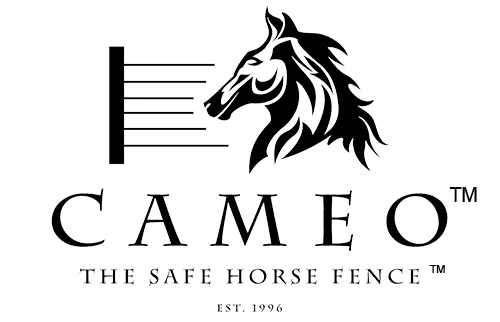Why Is Horse Fencing Safety So Important?
When it comes to caring for horses, safety begins at the fence line. Horses are naturally curious, powerful, and fast-moving animals—traits that make proper fencing an essential part of any equine property. The wrong type of fence can lead to serious injuries, escapes, or worse. That’s why choosing safe horse fence options is one of the most important decisions a horse owner or barn manager can make.
This article explores the risks posed by different fencing materials, best practices in fence design, and how proper visibility and height play critical roles in safety. It also highlights how the Cameo™ Horse Fence System addresses common equine fencing concerns with a modern, horse-friendly design built for long-term peace of mind.
Common Fencing Materials and Their Safety Risks
Each fencing material comes with pros and cons, especially when it comes to equine safety. Below is a breakdown of the most common horse fencing types and their associated risks:
| Material | Safety Risks | Notes |
|---|---|---|
| Barbed Wire | High risk of lacerations, entanglement, and infection | Not recommended for horses under any circumstance |
| High-Tensile Wire | Can cut or trap legs if broken or tensioned improperly | Use with protective coatings or sleeves |
| Woven Wire | Safer than barbed, but hooves can catch in large gaps | Must use small mesh to prevent entrapment |
| Wooden Board | Can splinter, break under pressure, or warp with weather | Requires frequent maintenance and repair |
| PVC or Vinyl Rail | Brittle in cold weather and may shatter on impact | Needs reinforcement; best used with electric backing |
| Electric Fencing | Can train horses to respect boundaries, but risk of entanglement remains | Should be visible and properly grounded |
| Monofilament (Cameo) | Flexible and low-injury risk if impacted | Ideal for high-visibility, safety-focused fencing |
Design Considerations That Prevent Injuries
Beyond the material itself, the design and construction of a fence play a critical role in safety. Here are the top design principles to follow when choosing or building a horse fence:
-
Height: A safe horse fence should be at least 54 to 60 inches tall for most adult horses. Taller breeds or stallions may require additional height.
-
Smooth Surfaces: All surfaces should be free of sharp edges, exposed nails, or broken boards that can snag skin or manes.
-
Proper Spacing: Avoid large gaps between rails or wires that could allow a hoof, leg, or head to get trapped.
-
Sturdy Corners and Gates: These areas are often stress points. Reinforce them well to avoid sagging, collapse, or escape attempts.
-
Visibility: Horses must be able to clearly see the fence—particularly if it’s electrified or tension-based.
A well-designed fence is not only safer, but it also teaches horses to respect boundaries without fear or confusion.
Why Fence Visibility and Height Matter
Poor visibility is one of the most common causes of fence-related horse injuries. Horses have excellent peripheral vision but struggle with depth perception—especially at speed or in low light. If a fence blends into the background or appears inconsistent, a horse may run into it or try to jump it unnecessarily.
That’s why high-visibility fencing—like the white monofilament used in the Cameo™ system—is crucial. The clearer the boundary, the less likely a horse is to misjudge it or attempt to challenge it.
As for height, a fence that's too low invites jumping or leaning. Conversely, a fence that's too tall with no middle rails may make it easier for foals or smaller horses to slip under or between lines. Multi-strand systems with evenly spaced rails are ideal.
Real-Life Examples: Fence Safety Successes and Failures
Failure:
At a small boarding barn in Georgia, a horse sustained a deep leg laceration from an exposed wire on an old barbed fence. The fence hadn’t been checked in over a year, and the damage required surgery and a four-month recovery.
Success:
In Colorado, a facility using Cameo™ Horse Fence System reported zero injuries over five years, even with young colts and aggressive geldings on the property. The flexibility of the monofilament line allowed horses to bounce off instead of breaking through or cutting themselves.
These examples reinforce a simple truth: the safest horse fences are those that are both highly visible and designed to absorb impact.
How Cameo™ Horse Fence System Improves Equine Safety
Cameo™ Horse Fence System is designed to address the most common fencing injuries and frustrations by providing:
-
Monofilament Flexibility: The fencing line stretches on impact, minimizing injury risk.
-
High Visibility: The white polymer line stands out clearly against almost any background, day or night.
-
UV-Stabilized Material: Withstands years of sun exposure without cracking, fading, or weakening.
-
No Sharp Points or Wire Ends: All brackets and connectors are smooth and designed to prevent snagging.
-
Multiple Strand Options: Choose the number and height of strands that best fit your horses and environment.
These features make Cameo one of the safest horse fence options on the market—especially for facilities that house spirited or unpredictable horses.
Internal & External Resources
-
Visit Cameo Fencing's full product line to learn more.
-
Read the article: Horse Fence Maintenance: Ensuring Safety and Longevity
-
Explore Equus Magazine’s fencing safety guide for additional reading on equine injury prevention.
Final Thoughts on Horse Fencing Safety
There’s no one-size-fits-all answer to horse fencing—but the safest systems are always the ones that prioritize visibility, strength, flexibility, and smart design. Whether you're housing young foals or seasoned competitors, the fence you choose plays a major role in your horse's health and happiness.
By choosing a system like Cameo™, horse owners can eliminate the most common fencing hazards and enjoy peace of mind for years to come.

